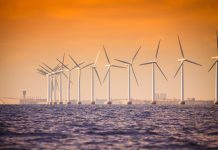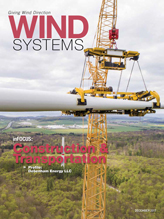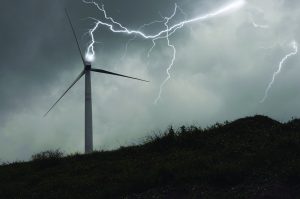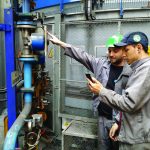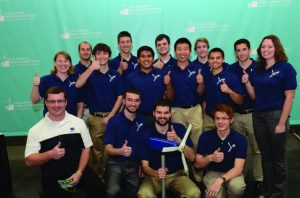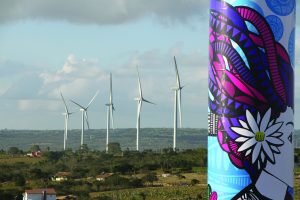As technology and economics contribute to wind turbines getting bigger and more powerful with each passing year, the Department of Energy is hard at work making strides in the opposite direction.
By awarding contracts through the National Renewable Energy Laboratory under the DOE-funded Distributed Wind Competitiveness Improvement Project (CIP), the goal is to make wind energy from small- and medium-sized turbines cost competitive with other distributed generation technologies and increase the number of wind-turbine designs certified to national safety and performance standards.
“There are a couple of reasons why we’ve invested in distributed wind,” said Patrick Gillman, a program manager with DOE’s Wind Energy Technologies Office. “We published this study with NREL in fall of 2016. It was the first quantitative assessment of the technical and resource potential for distributed wind deployment. And what we found was there are millions of sites around the country where distributed wind could potentially be viable. And those are small businesses, farms, homes — primarily in rural America — where distributed wind offers an opportunity for those consumers to take control of their own energy choices.”

Global Leader
With the fact that the U.S. is a global leader in small wind-turbine manufacturing, it’s easy to see how that aspect of the wind industry becomes an important area to sustain, according to Gillman.
“A substantial portion of sales from U.S. small wind-turbine manufacturers goes to markets abroad,” he said. “And they play very competitively over there. So this is a sector where we think investment to reduce the cost, so that technology can become more competitive with both local retail rates of electricity and other distributed energy resources, is warranted to have a major impact on the electricity sector in the U.S.”
But Gillman said analysis has shown there also is a big potential market in rural and far suburban communities.
“I don’t think we’re claiming that you’re going to throw up a turbine on every roof in an urban area,” he said. “That’s not likely to be viable. But there are lots and lots of sites in rural and far suburban areas where small turbines or even medium-sized or larger turbines at commercial or industrial sites would make economic sense to meet electricity demands.”
Distributed Wind Goals
By supplying funding to research and development through the Competitiveness Improvement Project, the DOE hopes to lower costs on the overall picture of distributed wind.
“The goals of that are really twofold: One is to do cost shared R&D to reduce the levelized cost of energy from distributed wind systems to the point where it competes with retail rates and other distributed energy resources,” Gillman said. “The second goal of the program is to increase the number of systems that are certified to national standards, so that whomever it is who is buying a small wind turbine can be assured that it will perform as advertised. Both of those things help reduce the cost.”
That means giving small turbine manufacturers access to the same levels of innovation available to the larger wind industry, according to Gillman.
“These are typically small businesses; they’re not backed by billions of dollars in venture capital,” he said. “They’re not publicly traded companies. These are entrepreneurs, and so federal investment in research and development really helps them drive costs out of their machines. A little bit here goes a long way.”
Big Wins
With the fifth round of CIP funding, Gillman said the results already are producing some big wins.
“In a previous round, we had an award to Bergey Windpower of Norman, Oklahoma, to do a redesign of the rotor on their flagship turbine, which they had been selling more or less unchanged for a long time,” Gillman said. “Working with NREL and working through the R&D process with our funds, they were able to redesign that machine so that, for approximately the same installed cost, they’re going to get double the amount of energy out of it, which means your levelized cost as a consumer is cut in half.”
And what that translates into is wind is now able to compete against other renewables such as solar in areas that it couldn’t before, he said.
That Bergey turbine is currently undergoing certification and is expected to be on the market early in 2018.
New work from the CIP funds is being implemented by Northern Power Systems in Barre, Vermont. The company is redesigning its 100 kW NPS 100 turbine from the ground up, looking to significantly increase its rotor size, according to Gillman.
“The goal there, similarly, is to significantly lower the cost of energy that comes from that machine,” he said.
Innovation is Key
The R&D and innovation that is going into these small to medium turbines has brought about some outside-the-box ingenuity, according to Gillman.
“From the perspective of what the turbine looks like, we are agnostic to that,” he said. “What we basically say is: If you come to us with a machine and you make a credible case — this is competitively awarded funding — so if you can make a credible case to the experts at the lab who are soliciting these proposals that your technology, based on the physics, is viable, you can hit a relevant cost number, and based on your engineering, that cost number is believable, then you stand a good chance of receiving funding under this program, regardless of what your machine looks like. And on the certification side, regardless of what your machine looks like, if you can show us that you have a credible case that you will be able to meet the standards set out for certifying your machine for performance and safety, you stand a good chance of your funding getting certified.”

Complementary, Not Competitive
Gillman said it is important to note the distinction between utility-scale wind and distributed wind.
“Our goal is not to make small wind turbines competitive with utility-scale wind or with utility-scale solar and natural gas,” he said. “There are inherent economies of scale that result in a lower LCOE from a multi-megawatt turbine than you’re likely to get to realistically in the foreseeable future with a much smaller machine. That said, that’s not what they need to do in order to get deployed and to make a contribution to the market. What these machines are designed to do is to help you as a consumer offset your electricity load at your site or in the context of small microgrid situation or off-grid situation.”
Distributed energy should be seen as complementary technologies.
“They have a lower hurdle to cross in the sense that you are looking at a small wind turbine,” Gillman said. “What you really want to know is: Is it cheaper than the cost of electricity I’m paying as a consumer now? Is it cheaper than the retail rates I’m paying? And is it cheaper than the alternative distributed energy resources that I could otherwise be using to meet my load? Is it cheaper than a solar voltaic system for my site?”
Another of the program’s goals is not to make distributed wind cheaper than, for example, distributed solar at every conceivable location, but to make it as competitive as it can be in enough locations in order for people to take advantage of the opportunity and build these machines, he said.
100 kW Range
The turbine sizes the CIP funding targets are machines from 1 kW up to 1 MW, according to Gillman. Even though 1 MW machines are eligible, he said the program typically focuses on machines around the 100 kW range.
A wide range of technologies at a wide range of sites will help reduce the overall costs of these machines, he said.
“If we can reduce the cost enough over the next five or 10 years, we think we can get distributed wind technology, small wind turbines, to the point where, in an unsubsidized market, they’re viable across a significant portion of sites across the country,” Gillman said.

















